The Best Air Purifiers of 2020
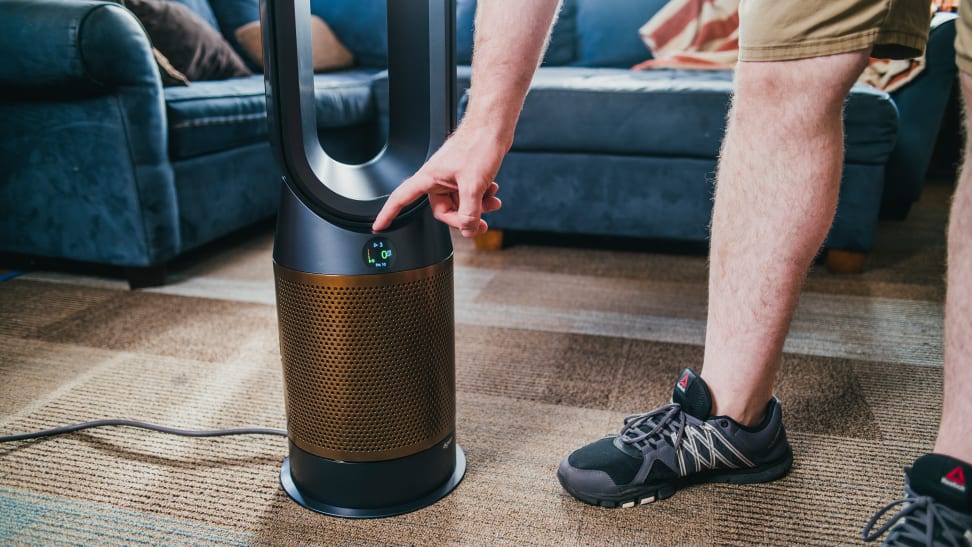 — Recommendations are independently chosen by Reviewed’s editors. Purchases you make through our links may earn us a commission.
— Recommendations are independently chosen by Reviewed’s editors. Purchases you make through our links may earn us a commission.We've just updated this article to include a bunch of new air purifiers, including our new upgrade pick, the Dyson Pure Hot + Cool Cryptomic.
These days, there are plenty of reasons to worry about your air quality. Whether you live in a city or in the country, there are all types of air pollution—from smog and wild fire smoke to allergens, mold, and gas fumes. Breathing heavily polluted air can have a number of negative health effects, including minor irritations like coughing and sneezing or an allergy in the short term, to chronic bronchitis and lung cancer for those who suffer long-term exposure.
While air pollution and smoke aren't major concerns in most places in the United States, more and more people are turning to air purifiers as a way to gain some peace of mind about the air and airborne particles they are breathing in. Air purifiers cleanse air in the same way filtered water pitchers cleanse drinking water—they use a series of increasingly fine filters, devices, and chemicals to remove or reduce pollutants from the ambient air inside a household. With consistent use and proper maintenance, air purifiers have been shown to noticeably mitigate the negative side effects related to inhaling air pollutants, especially in vulnerable populations like young children and the elderly.
However, not all air cleaners are created equal; they vary in effectiveness, filter capture, user-friendliness, and aesthetics. After months of testing air purifiers, the Winix 5500-2 (available at Amazon for $147.19) came out on top as our favorite air purifier because of its strong air cleaning performance and streamlined interface.
These are the best air purifiers we tested ranked, in order:
- Dyson Pure Hot + Cool Cryptomic
- Winix 5500-2
- Wynd Home
- Sharp FPK50UW
- Blueair Classic 205
- Bissell air220
- Vornado AC550
- Honeywell HPA200
- Blue Pure Fan
- Blue Pure 211+
- LG AS560DWR0
- Honeywell HPA250B
- Dyson Pure Hot + Cool
- Coway AP-1512HHS
- Blueair Classic 480i
- Blue Pure 411+
- Rabbit MinusA2
- Alen BreatheSmart 75i
- Holmes HAP9726B
- LG AM501YWM1
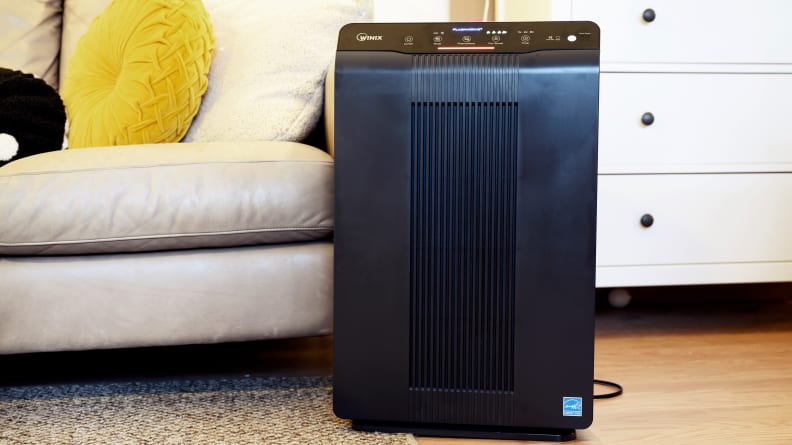

Our findings show that the Winix 5500-2 is the best air purifier for most people.
Purification method(s): True HEPA filter, carbon filter, plasma
Recommended main filter replacement: Every 12 months
Filter replacement cost: $80 for 2-pack containing HEPA and carbon filters
The Winix 5500-2 air purifier, while not the most technologically advanced air purifier on our list, has intuitive controls and thoughtful extras like a sleep mode, a timer, and a light sensor that automatically adjusts the back-lighting on the control panel. It also comes with a number of status lights for the filter integrity, air quality, and odor detection. Changing the filters is easy, and most of the fan settings were quiet enough to not prove disruptive during conversations or at night.
While the Winix 5500-2 employs plasma as one purification method, it is certified by the California Air Resources Board, meaning that it emits minimal, safe levels of ozone. If you have a strong ozone sensitivity, though, all you have to do is turn the PlasmaWave function off.
The Winix 5500-2 air purifier did well in our smell tests; it was able to noticeably diminish the smell of odors like cinnamon and cigarette smoke. Of the two scents, cigarette smoke seems to be more pervasive, so the fact that the Winix was able to remove enough smoke that not all of our testers could immediately identify it is praise-worthy. These smell tests, it must be noted, were conducted without the PlasmaWave function, so regardless of whether you use it or not, you should see strong air cleaning performance.
Our testers also commented favorably on the Winix's ability to make a basement seem less musty, and to noticeably diminish cooking smells as well as the amount of allergens in the air. If you want to see an improvement in your air quality, and don't need a lot of high-tech features, the Winix 5500-2 air purifier won't let you down.
Pros
-
Easy to move
-
Easy to change filters
Cons
-
None that we could find
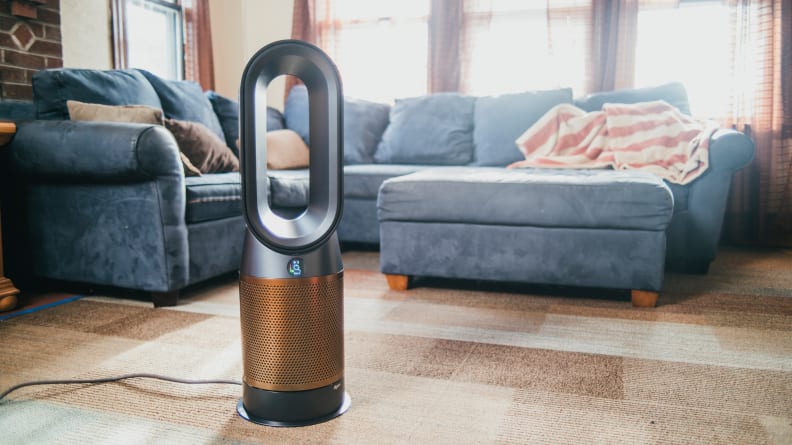

The Dyson Hot + Cool Cryptomic air purifier has an extra filter that targets formaldehyde particles in the air.
Purification method(s): HEPA filter, carbon filter, permanent cryptomic panel
Recommended main filter replacement: Variable, depending on the environment, but typically every 12 months
Filter replacement cost: $80 for a 2-pack containing two HEPA filters
The Dyson Pure Hot + Cool Cryptomic (HP06) is the latest coup in air quality control from Dyson. While a lot of the features are similar to those in previous iterations of the Dyson Pure Hot + Cool air purifier, the presence of a permanent cryptomic panel helps to remove formaldehyde.
At first, this formaldehyde may seem to be a strange particle to focus on, since we typically think of formaldehyde as something that’s found in funeral homes rather than our own homes. However, formaldehyde is actually a volatile organic compound (VOC), a class of contaminants with particles that are small enough to make their way through the human body, leaving all sorts of problems in their wake. Formaldehyde is a probable human carcinogen that is found in construction materials, paints, cigarette smoke, and some cosmetics.
While some air purifiers on the market can filter out particles with a diameter as small as one micron (PM1.0), formaldehyde is one of those tricky particles that is small enough to squeeze through those filters. The permanent cryptomic panel in the Dyson HP06 is said to trap formaldehyde particles and render them into less harmful particles such as water vapor and (minimal amounts of) carbon dioxide.
The information panel on both the machine and in the Dyson Link app (iOS/Android) provide real-time information about the temperature, humidity, and air quality (including the VOC, NO2, PM10, and PM2.5 content) of your room.
From the app, you can set voice commands (through Amazon Alexa or Siri) and change every setting on the HP06, with the exception of the temperature (which can be changed via the remote). This air purifier can also be used without the app; its unique shape makes it easy to lift and move around.
Filter replacement is a breeze. (Note: while replacement filters are relatively expensive, it is recommended that you purchase them directly from Dyson, as there have been counterfeit Dyson products sold on from online retailers in the past.)
When it came to performance, we were just as impressed with the Dyson HP06 as we were with the HP04, which we tested in an earlier iteration of this article. Our tester loved the 350-degree oscillation option, which spins the air purifier around in nearly a full circle. In the at-home smell tests, the HP06 easily dispelled the smell of cooking bacon and bleach (but obviously not at the same time). During our smell test in the lab, the Dyson did a pretty good job of removing the smell of cigarette smoke; only a hint of a menthol smell remained after it ran for four hours.
The Dyson Pure Hot + Cool Cryptomic is seriously expensive. But for gadget fiends, those with serious concerns about formaldehyde in your air, or those who don’t have permanent heating or cooling options in their homes, it might be worth the investment.
Pros
-
Multi-purpose heating/cooling/air purifying appliance
-
Provides a lot of air quality info
Cons
-
Expensive
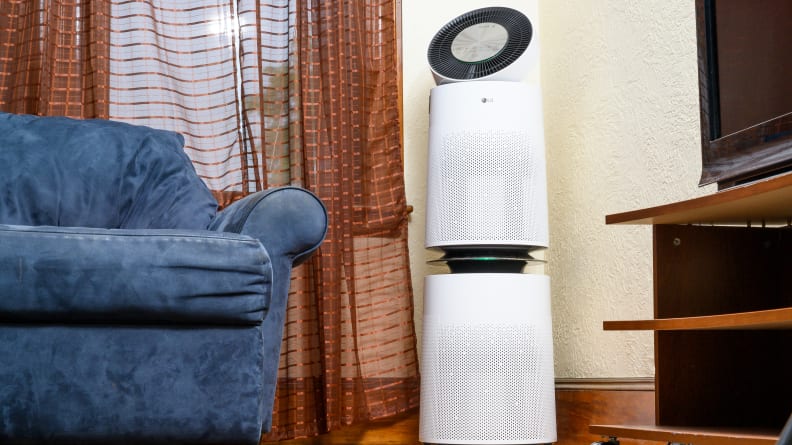
Coming in at around four feet tall, the LG AS560DWR0 air purifier has a whole host of smart features.
Purification method(s): ultra-fine pre-filter, True HEPA filter, sorbent filter
Recommended main filter replacement: Every 12 months
Filter replacement cost: $130 for combination True HEPA filter and sorbent filter
If you're a big fan of smart home devices, clean air, and sleek design aesthetics, then you are going to be pleased as punch by the LG AS560DWR0 air purifier. This air purifier is essentially two smaller air purifying units stacked on top of one another, with an additional fan on top. It looks like a robot from the future, especially when you turn it on, the fan (the "booster") slowly rises, and the display lights up.
With the tap of a button, you can bring up the modules that show you the concentrations of PM10, PM2.5, and PM1.0 particulates, make the whole unit rotate, check the filter status, and more. You can even track your air quality on your phone though the SmartThinQ app, and the app's compatibility with Amazon Alexa and Google assistant means that you can communicate with your air purifier to your heart's content. The high price for this air purifier is doubtlessly driven by the fact that it has many extra features, strong air cleaning abilities, and a luxury aesthetic.
During testing, the LG AS560DWR0 knocked it out of the park when it came to removing fragrance smells (one of the few that did), but didn't do as well with cigarette smoke. The wide range of air purification settings and options means that you can easily find a setting that isn't too loud during the day or night. As you might expect of an air purifier this tall (nearly 4 feet tall), it's heavy (over 40 pounds), and not so easy to move.
Really, though, this air purifier belongs in one corner of a high-end living space, where it can be functional and admired, and it's priced accordingly. If you have disposable income, embrace the Internet of Things, and want to be able to know your air's quality with the touch of a button, the LG AS560DWR0 will fit in perfectly with the rest of your lifestyle and home decor.
Pros
-
Alexa and Google Assistant compatible
Cons
-
Tall and heavy
-
Expensive
How We Tested
The Tester
Hi there, my name is Julia MacDougall, and I’m the Senior Scientist here at Reviewed. I’ve tested a wide variety of products, including rakes, shredders, backpacks, smart thermostats, and coding toys for kids.
I have allergies (both plant- and animal-related) that follow me around wherever I go. My friends know that if they don’t see me flash a packet of tissues at least once while I’m out, chances are I’ve been replaced by an allergy-free clone. Naturally, I was hyped to test out air purifiers because I was curious to see if air purifiers really work, especially when it comes to allergens and other airborne irritants.
The Testing Area
To test air purifiers in the lab, I built an airtight room with a footprint of approximately 200 sq. ft., which is about the size of a large bedroom or a small- to medium-sized living room.
The only place I could fit such a room was in the basement, so I went ahead and upped the creep factor. To make matters worse, in the initial phase of testing, I set off a red smoke grenade to see if the air purifier could clear the room (spoiler alert: it can, but it completely clogs the filters), and as a result, the room’s walls were slightly red-tinged from then on, looking like a scene out of Dexter.
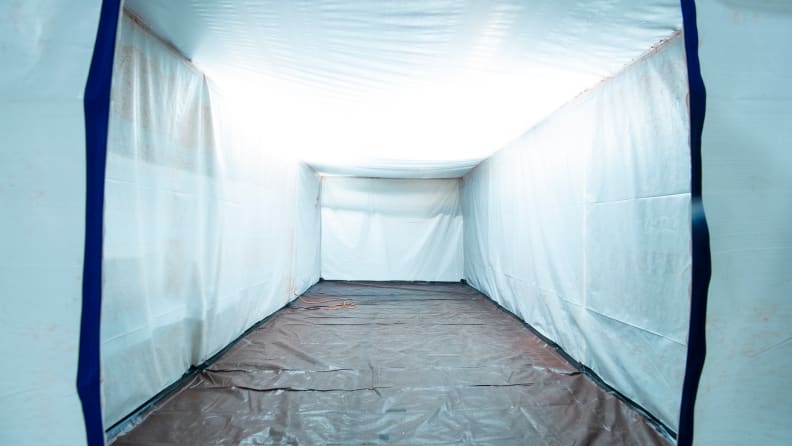
The room I used for testing air purifiers was airtight, and about the size of a large bedroom or small- to large-sized living room.
Anyway, to make a long story short, I built an airtight room in the basement so that I could test the air purifiers by replicating the way someone might use it in their home, and without having to worry about external air currents or smells.
The Tests
I tested the air purifiers in two ways: casual usage and smell tests. I asked volunteers to take each air purifier home and use it for two weeks, then to use a different air purifier for an additional two weeks. Volunteers then filled out surveys containing questions about user-friendliness of the air purifier, as well as their impressions as to whether the air purifier worked well in their homes.
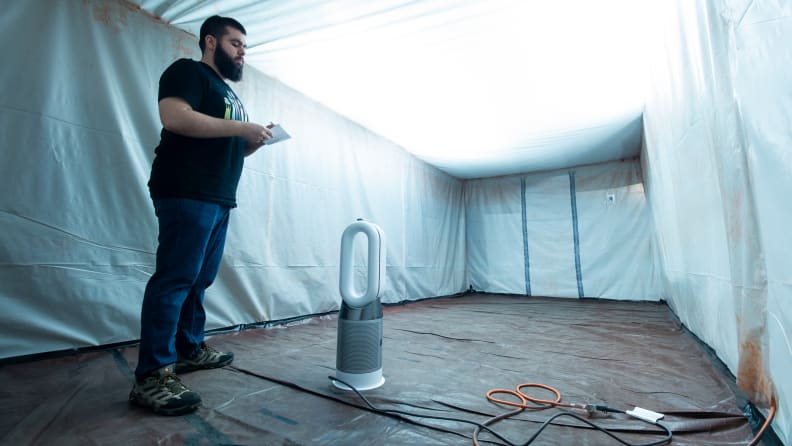
During testing, people filled out surveys asking them if they could identify the smell in the room after the air purifier had been running for hours.
The smell tests were conducted in the air purifier testing room. I would introduce a smell (cigarette smoke, fish oil, essential oils) into the sealed room for 20 minutes, run the air purifier on its highest fan setting for four hours, and then asked people to identify what they smelled: a smoky smell, a spice/fragrance smell, a fishy smell, an unknown smell, or no smell at all. The more “smell confusion,” a term I made up that defines the way people have a tough time identifying a specific smell, the better the air purifier did at removing that smell from the room.
Unfortunately, we were unable to test exactly how well the air purifiers work in a scientific sense—that is, measuring the size and type of particulates in a room before and after using an air purifier. (If you want that information, check out the guides from our friends at the Wirecutter and Consumer Reports). However, we’re still confident in our testing, because it allows us to replicate the experience someone actually using the air purifier in his or her home would have, since air particulate differences detected by machines are not necessarily detectable by humans.
What You Should Know About Air Purifiers
How Do Air Purifiers Work?
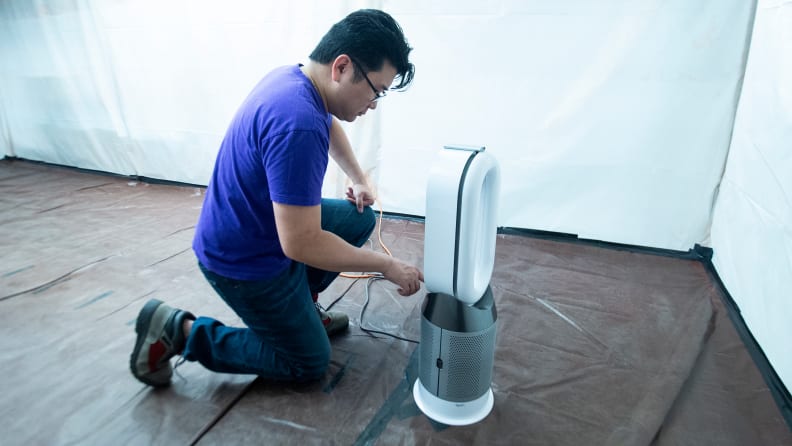
Air purifiers use a variety of mechanical, chemical, and electric filtration mechanisms to remove pollutants from the air, as we discovered during lab testing.
Air purifiers operate under the same basic principles as space heaters and air conditioners. They draw air in using a series of fans, condition the air in some fashion, and then use fans and blowers to send the air back out into the room. In the specific case of air purifiers, the “conditioning” involves the air being passed through a number of filters and devices that remove air impurities physically and electrically. Here are the main types of filters/air purifiers that catch larger particles:
Fibrous air filters are air filters with fibers going in all directions that are meant to catch particulates of a certain size (the density of the weave goes up as the size of the particles removed goes down) physically, like a net.
Electrostatic precipitators (ESPs) and ionizers both involved charged particles. With ESPs, a live wire charges the particles coming in, and an oppositely-charged electric plate collects the particles as they pass through the air purifier. As for ionizers, they generate charged particles that are attracted to other charged particulates in the air, and once they combine, sink under their own weight to settle on floors, walls, or other surfaces.
Ultraviolet germicidal irradiation (UVGI) air purifiers use internal UV lamps to kill biological material like viruses, bacteria, and mold.
For those air purifiers/filters that are looking to remove smells, gasses, and vapors, the filters are designed to remove these particulates chemically; this is most commonly done with sorbent media, photocatalytic oxidation (PCO), and plasma.
Sorbent media uses the fact that particles are attracted to certain molecules to absorb and trap certain particles. Activated carbon and silica gel are two of the more frequently used sorbent media filters.
Photocatalytic oxidation (PCO) uses a combination of UV lamps and sorbent media to create ions that oxidize the gas particulates and change their chemical composition until only carbon dioxide and water remain.
Plasma air purifiers are similar to PCO, in that they remove pollutants by creating ionized particles that attach to pollutants and change their chemical composition by oxidation, but they do this without a sorbent media. However, plasma air purifiers may give off ozone. Any air purifier that creates ozone is not recommended because ozone is a lung irritant that may be bothersome to humans.
Long story short: Air purifiers use a number of different filtration methods to remove air pollutants large and small.
Do Air Purifiers Actually Work?
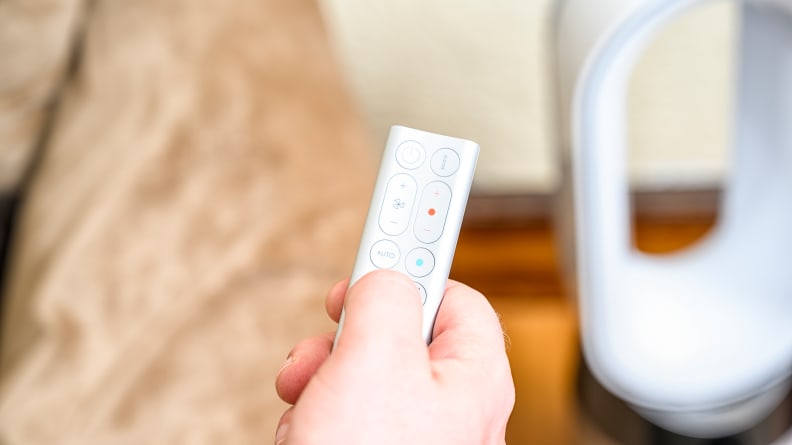
For air purifiers to be effective, you have to actually turn them on. If your model is too loud, consider using a lower, slower setting.
Yes, air purifiers actually work. Multiple studies show that air purifier usage can have a mild to moderate positive effect on air quality and, subsequently, human health. Although, as with all things, some products work better than others at removing air pollutants quickly and efficiently.
According to the EPA, the problem isn’t that air purifiers don’t work, it’s that people who have air purifiers have a tendency to not use them at all or at the best settings because they’re too loud or because they require frequent maintenance and filter cleaning/replacement to operate optimally. As a result, more and more air purifier brands are making an effort to prioritize quiet operation and easy filter replacement so that customers can get the most out of their air purifiers.
Long story short: Air purifiers work as long as you actually use them and maintain them.
Do You Need An Air Purifier?

Air purifiers, like the Blue Pure 211+ air purifier shown here, can help remove airborne allergens, mold spores, and odors.
Despite the fact that the market for residential air purifiers is growing rapidly, chances are that your air quality is fine and that the absence of an air purifier is not going to have dire health consequences for you and your family. However, there are a few circumstances where air purifiers are highly recommended:
Someone in your home has trouble breathing on a regular basis (allergies, asthma, chronic bronchitis, emphysema, etc.)
You have pets that shed fur and dander
You have very young children or older folks in your home
You live in a state/city/town that has persistent issues with outside air quality (smog, wildfire smoke, etc.)
You live near industrial facilities that generate strong fumes (factories, air bases, gas stations, etc.)
You live in an area where rot and/or mold may be a concern
Someone in your home has a strong aversion to certain smells
Long story short: If the air quality in your home can affect or exacerbate the existing health issues of you or your loved ones, or if you suspect the air quality might be the cause of a health issue, it might make sense for you to purchase an air purifier. Otherwise, you might want to skip buying an air purifier.
What is a HEPA Filter?
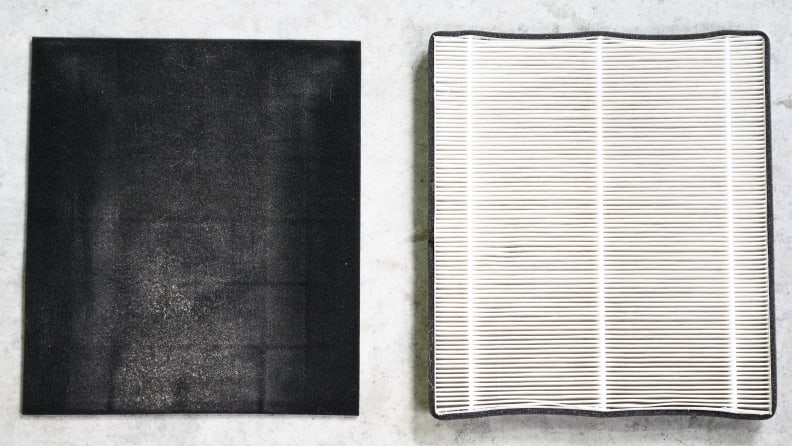
The Vornado AC550 air purifier uses both a sorbent pre-filter (left) and a True HEPA filter (right) to remove pollutants from the air.
When looking at the specs for an air purifier, pay very careful attention to the language used to describe the type of filters it uses. You’ve probably heard of HEPA filters before, they’re in all sorts of appliances, like vacuums, air conditioners, and air purifiers. HEPA filters are often highly folded and made up of a bunch of fibers that have been forced together at a bunch of different angles so as to increase the likelihood of catching a particle, large or small, and removing it from the air. HEPA filters are known to be among the most effective filters, so it makes sense that everyone’s keeping an eye out for HEPA filtration when it comes to buying an air purifier.
However, it can get confusing because the testing standards often invoked to qualify a filter as a HEPA filter apply specifically to air purifiers and air furnaces used in industrial, medical, and government buildings. According to the EPA, “…there is no widely accepted definition of HEPA performance in consumer products.” As a result, there is a chance that the claims made about the HEPA filters on any air purifier have not been verified by an independent third party. However, there does seem to be general agreement on the marketing terms that describe how good a HEPA filter is:
True HEPA/HEPA filters are the HEPA filters with the best filtration. In spite of the fact that the EPA says there’s no strict definition for HEPA filters used in consumer products, True HEPA filters are commonly defined as being able to remove 99.97% of particles that have a diameter of 0.3 microns (for reference, there are 10,000 microns in a centimeter).
HEPA-like/99% HEPA/HEPA-type/HEPA-style filters are filters that are less effective than normal HEPA and True HEPA filters. Typically, this means that they are not able to filter out particles with diameters as small as 0.3 microns, but are able to filter out larger particles (usually on the order of 2 microns) with an efficacy of about 99%.
Long story short: If your air purifier’s filtration abilities really matter to you, read the fine print when it mentions the size and efficacy of its filters, and only use the “HEPA” marketing language as a general guideline, not the major factor when it comes to your purchasing decision. The smaller the micron number mentioned in the filtration spec, and the higher the efficacy (i.e. the number of 9's that follow the decimal place after 99%), the better.
What Is The Clean Air Delivery Rate (CADR)?
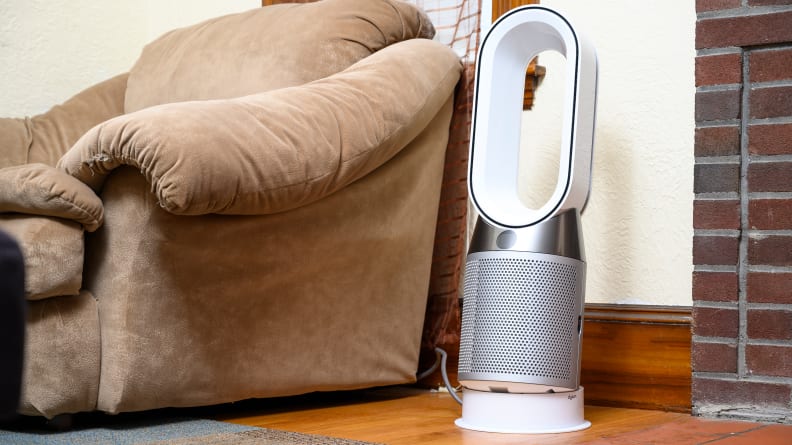
The Dyson Pure Hot+Cool has an overall Clean Air Delivery Rate (CADR) of 80 cubic feet per minute.
The Clean Air Delivery Rate (CADR), unlike the HEPA filtration on consumer products, is actually determined and verified by an independent testing lab using AHAM standard AC-1. The CADR values are rated in terms of cubic feet per minute (cfm); basically, it’s a measure of how quickly a given air purifier can reduce the amount of dust, pollen, and smoke in a room to levels that would be equivalent to adding completely clean, uncontaminated air to the same space. Based on this standard, CADR values max out at 450 cfm for pollen and smoke, and 400 cfm for dust. The higher the CADR value, the faster the air filtration.
However, there are several interesting points to note about CADR. First, while CADR is a valuable and reproducible way to help customers know how quickly air can be filtered through the air purifier, there is some debate amongst those in the industry as to how relevant this standard is, since the testing conditions (which involve extra circulation fans) are not very similar to those seen in consumers’ homes. Second, CADR is typically measured with the air purifier on its highest filtration speed; depending on the air purifier, consumers may not actually use the air purifier on its highest speed because it may be too loud. Lastly, the AHAM standard states explicitly that if you see CADR values that are higher than the maximum values (450 cfm for pollen and smoke, and 400 cfm for dust), then those numbers cannot have the same statistical significance as values than those that do fall in the stated CADR range, so their validity is questionable.
Long story short: Look for higher CADR numbers to guide your eye, but again, don’t let it make your break your purchasing decision. Be aware that the CADR value is an ideal value, and know that your typical CADR may be lower than the number on the air purifier’s box.
What Types of Pollutants Can Air Purifiers Filter Out?
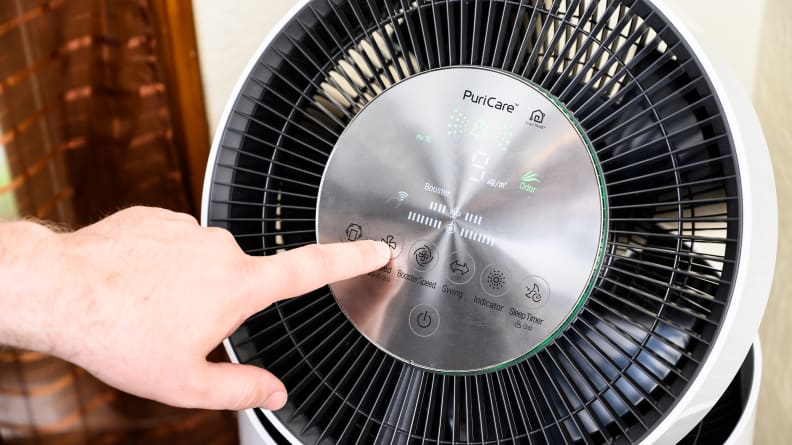
Some air purifiers have displays that show you the concentration of air pollutants.
The types of particles that air purifiers can filter out are usually categorized by size. The four major groups of particulates, with respect to air quality, are:
Particulate matter < 10 microns (PM10) — Pollutants with diameters smaller than 10 microns. Small enough to be absorbed in the tissue of the lungs and heart. Examples: pollen, mold spores, visible dust
Particulate matter < 2.5 microns (PM2.5) — Pollutants with diameters smaller than 2.5 microns. Small enough to be absorbed deep into the lungs and into the bloodstream. Examples: allergens, pet dander
Particulate matter < 1 micron (PM1.0) — Pollutants with diameters smaller than 1 micron. Small enough to propagate throughout the body. Examples: smoke, bacteria
Volatile Organic Compounds (VOCs) & Gasses — Pollutants with diameters at or less than 0.01 microns. Small enough to propagate throughout the body. Examples: benzene, propane, pesticides, cooking odors
In general, most air purifiers can filter out almost all of the PM10 pollutants, moderate amounts of PM2.5 pollutants, and have a tough time with PM1.0 pollutants and VOCs and gasses. If air purifiers address PM1.0 and VOCs/gasses at all, they typically need additional filters that are made out of an odor-absorbing material or are of an even finer mesh than the regular filter, which is designed to catch particulates in the PM2.5 and PM10 range.
Long story short: Air purifiers are able to catch relatively common air pollutants like allergens, mold, and dust, but it is much more difficult for air purifiers to filter out the smaller particles like gasses, VOCs, and PM1.0. Sadly, these particles are the most dangerous to humans because the particles are small enough that they can seep into the bloodstream through the lungs and cause damage throughout the body away from the place where they were initially inhaled.
Other Air Purifiers We Tested
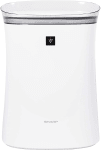
Purification method(s): True HEPA filter, carbon filter, pre-filter, plasmacluster technology
Recommended main filter replacement: Every 24 months
Filter replacement cost: $70 for a True HEPA filter
The Sharp FPK50UW is a sleek but powerful air purifier with enough options for those who want some flexibility with their air purification, but don’t need or want a smart air purifier. It features three fan speeds (including a “Sleep mode”) and a “Express Clean” option that uses ionized particles to remove contaminants from the air for up to 60 minutes. There’s also a timer option for two, four, and eight hours.
Our in-home tester really loved the “Express Clean” setting, which cleared kitty litter dust from the air with no problem. It had a bit of a tougher time removing the smell of bacon from the air, but did a decent job of removing the smell of cigarette smoke from the airtight test room during lab testing.
While “Express Clean” and the high fan speed are both very loud, either setting can be used to quickly clean the air in a small room with a door that closes. With its small size, low weight, and deep handle, this air purifier is very portable. For proof that good things come in small packages, check out the Sharp FPK50UW.
Pros
-
Easy to operate
-
Easy to move
Cons
-
Half of the fan speeds are loud
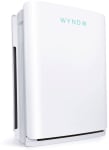
Purification method(s): HEPA filters
Recommended main filter replacement: Every 12 months
Filter replacement cost: $80 for a 2-pack containing 2 HEPA filters
A relative newcomer, the California-based start-up Wynd recently expanded their popular personal air purifier line of products to include a whole-room air purifier. The Wynd Home Purifier has four fan modes (including an “Auto” setting), and is big enough (and powerful enough) to quickly clean the air in a larger room or multiple rooms arranged in an open floor plan.
While you can use the Wynd app (iOS/Android) to change a couple of settings on the air purifier (namely the lights and “Auto” mode), those who are passionate about their air quality will want to use the Wynd Home purifier in conjunction with the Wynd Halo, a portable air quality sensor that usually comes in a bundle with the air purifier.
Once the Wynd Halo is set up, you can pair it with the air purifier. With the air quality data, the air purifier can automatically ramp up its cleaning to get rid of any odors or air contaminants it senses with the Halo. In the Wynd app, you can also take a look at your air quality stats, both in your home and in your city. We found the Wynd app to be a bit buggy, but responses to user feedback on the Android and iOS app stores indicate that Wynd will be releasing another version of the app shortly.
Note: the smart aspect of this air purifier only works on 2.4 GHz wi-fi networks, so if you only have a 5 GHz network in your home, you might not be able to take advantage of the Wynd’s smart features.
When it came to in-home testing, users subjected the Wynd Home Purifier to bathroom smells and burnt toast, both of which the Wynd dispatched with ease. During lab testing, however, the Wynd struggled a bit when it came to fragrance smells (most air purifiers do). While it can be tough to tell whether you’ve actually pressed one of the buttons on the air purifier, the accompanying status lights means that it only takes a couple of times before you start to figure out how responsive the buttons are.
Only the fastest fan speed is noisy, but again, that’s to be expected. While its size makes it a bit awkward to handle, with its relatively low weight and side handles, it’s pretty easy to move and lift this air purifier. The Wynd Home Purifier will both purify your air and help you to gain valuable insights about your indoor and outdoor air quality.
Pros
-
App contains lots of great air quality info
Cons
-
Smart features only work with 2.4 GHz wi-fi networks

Purification method(s): SmokeStop sorbent filter, HEPAsilent filter
Recommended main filter replacement: Every 6 months
Filter replacement cost: $60 for a HEPAsilent particle filter, $130 for a combination HEPAsilent particle and SmokeStop sorbent media filter
Beneath its industrial-looking exterior lies an air purifier that can get the job done. The Blueair Classic 205 air purifier has a very basic control panel only consisting of the power/fan control, the WiFi network indicator, and the filter status light.
The Classic 205 can be activated, adjusted, and monitored from the Blueair Friend mobile app, allowing you to improve your air quality even while you're on the go. The panel has a discreet cover that really helps at night when you don't want to be bothered by extra ambient LED lighting.
The Classic 205 had a tough time removing cigarette smoke, but it did a pretty good job of cleansing the room of the stench of fish oil, so we'd recommend using this air purifier near the kitchen so as to help eradicate unpleasant cooking, food, or food waste smells. At-home testing revealed that the Classic 205 might also help to mitigate allergy congestion when you first wake up in the morning.
While some of its settings can be a bit loud, we think the Blueair Classic 205 would be a solid air purifier for those bothered by food odors, and for those who don't want to grapple with a ton of purifier options and settings.
Pros
-
Unobtrustive aesthetics
Cons
-
Some loud fan settings

Purification method(s): HEPA filter, carbon filter, pre-filter
Recommended main filter replacement: Every 6 months
Filter replacement cost: $23 for a 2-pack containing the HEPA filter and the pre-filter, $19 for a carbon filter
The Bissell air220 is an intuitive, unobtrusive air purifier. It has a single power button and a fan speed dial with five fan speeds and an “Auto” mode. It has a tiny display panel that shows the fan setting, and three different LEDs give you general information about the ambient air quality. The air220 is designed to fade into the background, rather than draw the eye, a fact that will please those who don’t want a big obvious air purifier to break up the visual appeal of a room.
During at-home testing, users found that the air220 did a solid job of getting rid of pot smoke, but it struggled a bit more to remove the smell of incense. In our lab, it performed similarly, where it wasn’t quite able to dispel the smell of peppermint from our sealed test room after running for four hours.
The fastest fan setting isn’t too loud, and it automatically switches over to night mode and turns off the machine lights when it senses low ambient light levels. The Bissell has a nice cord storage system, but the too-shallow handle means that you have to hold it with two hands when moving it around. If you prefer the set-it-and-forget-it approach to air purifying, then you’ll appreciate the Bissell air220.
Pros
-
Easy to use
-
Relatively quiet operation
Cons
-
Inadequate handle

Purification method(s): carbon filter, True HEPA filter
Recommended main filter replacement: Every 12 months
Filter replacement cost: $15 for a 2-pack of carbon filters, $34 for a True HEPA filter
The Vornado AC550 is an air purifier that favors simplicity over aesthetics. It's interesting to look at, if not particularly modern in its design and operating it is very easy. With only a plus and minus sign button to toggle between the four fan speeds, sleep, and auto modes, and filter status lights, this air purifier is for those who don't want to read an entire manual front-to-back in order to understand how to make it work. In Auto mode, the dust sensor, located on the side of the unit, dictates the fan speed at any given moment, meaning that you won't have to constantly adjust it when the interior air quality changes.
When it came to our smell tests, the Vornado had a tough time removing the scent of a peppermint essential oil; most of the other air purifiers we tested also struggled with filtering out fragrance smells. It did pretty well when it came to the stench of fish oil, though, so it may be more successful in removing food and cooking smells. While some of the settings on the Vornado are loud, most are quiet enough that they weren't bothersome during quiet time or conversations.
Our at-home testers appreciated that the Vornado is very light, and can be moved with one hand, using one of the pocket handles on the side of the machine. If you want an air purifier that you don't have to babysit, and is portable and user-friendly, we'd recommend the Vornado AC550.
Pros
-
Easy to operate
-
Easy to move
Cons
-
Some loud fan settings
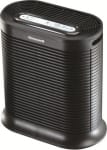
Purification method(s): sorbent pre-filter, True HEPA filter
Recommended main filter replacement: Every 12 months
Filter replacement cost: $60 for one True HEPA filter and one sorbent filter
The Honeywell HPA200 is one of the more basic air purifiers on the market today, but it is effective and user-friendly. While its interface is simple, it has four different cleaning modes (General Clean, Allergen, Germ, and Turbo), and those options offer enough flexibility that you'll be able to use this air purifier in a number of different circumstances, particularly when pollen is bad or when family members get sick.
Other features include a timer, filter status lights, and a dimmer function that allows you to adjust the level of panel lighting as needed.
While the HPA200 did a pretty good job of filtering out fish oil during our smell test, it had a tougher time removing the lemon essential oil smell from our test room. The HPA200 should put a decent dent in your cooking smells, and, as we learned during in-home testing, drastically reduced the number of airborne allergens.
Some of the settings got pretty noisy, so you might have to either use the timer function or run it on a lower setting if you want to run it while sleeping. The Honeywell HPA200 air purifier is unobtrusive, easy to use, and a good companion in the constant battle with airborne allergens.
Pros
-
Easy to operate
-
Easy to move
Cons
-
Some loud fan settings
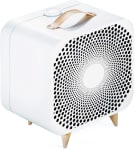
Purification method(s): Particle filter, optional fabric pre-filter
Recommended main filter replacement: Every 5-6 months
Filter replacement cost: $25 for a particle filter
The Blue Pure Fan cools you down and removes large particles from the air. While it’s not a dedicated air purifier like the other products on this list, it’s a gateway product for those who want to cool down and breathe in cleaner air at the same time.
This cooling fan has a stylish aesthetic and a simple control panel consisting of a single button that you press multiple times to access the different fan speeds. The fan speed LEDs change to yellow when it’s time to replace the particle filter. The optional fabric pre-filter is an attractive shade of blue, which fits in nicely with the overall design aesthetic.
Our at-home tester put this cooling fan through the wringer, and the Blue Pure Fan rose to the challenge. Despite it lacking a HEPA filter, the tester reported that this cooling fan noticeably reduced pet odors and cooking smells, and also made her home more livable for a roommate with a dust allergy. In the lab, we found that the Blue Pure Fan did a pretty good job of dispelling the smell of fish oil.
As with most fans and air purifiers, the highest fan setting is loud. Because this small cooling fan has a big handle, it’s very easy to move around, so don’t be surprised if you find yourself toting the Blue Pure Fan from room to room in the hot summer months.
Pros
-
Doubles as a fan
-
Easy to move
Cons
-
No HEPA filter
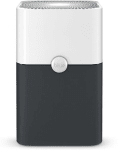
Purification method(s): fabric pre-filter, ionizer, particle and carbon filter
Recommended main filter replacement: Every 6 months
Filter replacement cost: $60 for combined particle/carbon filter
The Blue Pure 211+ air purifier is among the most streamlined and eco-friendly air purifiers we tested. With a washable fabric prefilter that doubled as a nice visual accent, a reusable metal frame that housed the particle filter, and the most basic control panel ever, the Blue Pure 211+ is sure to be a crowd-pleaser for those who want cleaner air without all the extra fuss.
The Pure 211+ has one large, central button that you tap repeatedly to increase the fan speed, respond to filter replacement reminders and turn the machine on and off.
The Pure 211+ did pretty well in our smell tests; however, it did better removing the smell of fish oil than it did the scent of lemon, so this air purifier is probably better for people who are plagued by cooking smells, rather than fragrances. Our in-home testing confirmed that slow-cooker smells while enticing for some, were no match for the air cleaning power of the Pure 211+.
It's also surprisingly light (albeit a bit ungainly), so if you want to move in into a different room, it's easy to do so. If you want an air purifier that is adorable and easy to maintain and operate, be sure to check out the Blue Pure 211+.
Pros
-
Easy to use
Cons
-
Lacks a HEPA filter
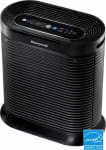
Purification method(s): sorbent pre-filter, True HEPA filter
Recommended main filter replacement: Every 12 months
Filter replacement cost: $60 for one True HEPA filter and one sorbent filter
Looks can be deceiving when it comes to the Honeywell HPA250B air purifier. Despite its old-school aesthetics (it looks identical to its sister product, the HPA200), its interface and capabilities are both modern and highly relevant to today's air quality concerns. In addition to the cleaning modes (the same as those found on the HPA200), this air purifier also has a VOC sensor, which, when activated, automatically sets the level of air cleaning to best eradicate any VOCs detected.
Even better, with the Honeywell Portable Air Purifier app, you can connect with your air purifier over Bluetooth. In the app, you can change the settings, set alerts for allergen levels, order filter replacements, and set a weekly schedule on which the air purifier can operate.
The HPA250B did a pretty good job at filtering out the smell of the nutmeg essential oil but did not perform as well when it came to filtering out cigarette smoke. Testers who took this air purifier home noticed a definite improvement in their air quality with respect to the rapid removal of cooking smoke and smells.
While some of the fan settings got pretty loud, this is offset by the fact that you can set a very specific schedule for the air purifier to follow, allowing you to have the air purifier clean the air when you're not home, and you can just come home to pollutant-free air. If you want an air purifier that is easy to use but still has some neat upgrades, spring for the Honeywell HPA250B.
Pros
-
Ease to use
Cons
-
Looks a little dated

Purification method(s): carbon filter, glass HEPA filter
Recommended main filter replacement: Variable, depending on the environment, but typically every 6-12 months
Filter replacement cost: $80 for 4-pack containing two carbon filters and two glass HEPA filters
We love Dyson vacuums and Dyson fans, so it's no surprise that we were excited to try out the Dyson Pure Hot + Cool (HP04), which is a combination of air purifier, heater, air conditioner, and fan. This air purifier has so many features and options that it'll make your head spin (in a good way).
You can use the Dyson app to monitor your air quality, change the settings, and check on the status of the filters. With its magnetic remote and display screen, you can easily toggle between modules that allow you to check indoor air quality, humidity, temperature, and PM10, PM2.5, PM1.0, and VOC content, among other things.
While the Dyson Pure Hot + Cool didn't do as well in our smell tests (smell testers were able to easily identify the cigarette smoke and lemon essential oil) as other air purifiers, we suspect that's because of the parameters of the smell testing, rather than any lack of ability on the part of the air purifier. During the smell test, the air purifiers ran for four hours; while the Dyson is designed to move air quickly, it has a smaller outflow grill than any other air purifier we tested, so it's not surprising that it might take longer to purify the air in a room. Those who tested the Dyson in their homes reported that their air felt fresher and that it did a solid job of improving their air quality.
For those who want the best out of an all-in-one air conditioning device or love spending time with gadgets, you can't go wrong with the Dyson Pure Hot + Cool.
Pros
-
Combination air purifier, heater, and A/C
-
Remote is easy to use
Cons
-
Expensive
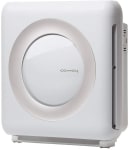
Purification method(s): True HEPA filter, activated carbon filter, pre-filter, bipolar ion technology
Recommended main filter replacement: Every 12 months
Filter replacement cost: $60 for a 2-pack with one True HEPA filter and two activated carbon filters
The Coway Airmega AP-1512HHS is an air purifier that’s been on the market for a while, and has a long history of very happy customers. Its streamlined, control panel has large buttons that are easy to press. Its five fan modes include "Auto" (which turns on when the air quality gets below a certain threshold) and "Eco" (which turns off automatically when no pollutants are detected after 30 minutes).
In the Coway IO Care app (iOS/Android), you can control your air purifier, get real-time air quality data, and set up air quality notifications. When left in "Auto" or "Eco" mode, these notifications will prompt the air purifier to turn on without your intervention.
Note: the smart aspect of this air purifier only works on 2.4 GHz wi-fi networks, so if you only have a 5 GHz network in your home, you might not be able to take advantage of the Coway’s smart features.
When our testers tried out the Coway in their homes, they found that this air purifier did a great job of getting rid of cooking smells such as ground beef, popcorn, and garlic. It struggled a bit more removing fragrance smells such as fruit-scented candles, an observation that we confirmed during lab testing, when we placed peppermint oil in our sealed test room. The faster fan settings are pretty loud, but that’s to be expected. With the convenient handle on the back and easy access to the filters, the Coway Airmega AP-1512HHS is effective and easy to use, whether you care about the smart features or not.
Pros
-
Easy to operate
-
Easy to move
Cons
-
Smart features only work with 2.4 GHz wi-fi networks
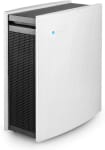
Purification method(s): SmokeStop sorbent filter, HEPAsilent filter
Recommended main filter replacement: Every 6 months
Filter replacement cost: $60 for a HEPAsilent particle filter, $150 for a combination HEPAsilent particle and SmokeStop sorbent media filter
The Blueair Classic 480i is the largest and most feature-laden of the Blueair air purifier models we tested. Like the Blueair Classic 205, the 480i can also be controlled remotely via the Blueair Friend app and has filter status lights on its hidden control panel. The 480i also has the same industrial look and feel as the 205, albeit on a bigger scale. In addition to having bigger, stronger air fans, this air purifier also has warning lights for high contents of VOCs and PM2.5 particulate matter, which can help you get a rough idea of your air quality at a glance.
When it came to the smell tests, the 480i was one of the better air purifiers when it came to removing fragrance smells, peppermint in particular. It did, however, struggle when it came to cigarette smoke. At-home testing revealed the utility of the app, which shows the air quality in real time; one of our volunteers moved the air purifier into a room that he was painting, and the decrease in air quality was immediate and visible in the app.
The high fan speed is loud, but the other fan speeds are quiet enough to not prove disruptive to sleep or conversation. Testers also found the air purifier to be a bit heavy and awkward to move, even if its rectangular shape lends itself to easy storage. If you want an air purifier with clean lines, a streamlined design, and useful air quality data, consider the Blueair Classic 480i.
Pros
-
Hidden control panel makes a good choice for bedroom use.
Cons
-
Expensive
-
Heavy and awkward to move

Purification method(s): Combination particle/carbon HEPAsilent filter, optional fabric pre-filter
Recommended main filter replacement: Every 6 months
Filter replacement cost: $22 for a combination particle/carbon HEPAsilent filter
The Blue Pure 411+ air purifier is a way for people to explore the possibility of cleaner air without spending a lot of money. Between its small size and its futuristic, cylindrical design, it’s easy for this air purifier to fit into any home. If you want to make the air purifier less noticeable, you can use the optional black fabric pre-filter, which easily slips over the outside of the air purifier. You can switch between the three fan speeds by tapping the central button multiple times.
When our tester took this air purifier home, he put it through its paces by subjecting it to sweaty workout clothes and the smell of cooked onions, both of which the Blue Pure 411+ handled pretty well. In our lab smell test, it had a tougher time removing cigarette smoke from our airtight testing room, but that’s not surprising for an air purifier that has filters that are less dense than traditional HEPA filters. We also noticed that, when we tried the Blue Pure 411+ in another room after the cigarette smoke test, the clean air that it vented out had a smoky odor; if you do need to use this air purifier to get rid of more intense smells or contaminants, be sure to let it air out a bit afterwards before using it again.
The fastest fan setting is loud, but not as loud as some of the larger air purifiers we tested. While the Blue Pure 411+ lacks a handle, it’s light enough that you can simply pick it up and move it as needed. If you want a basic air purifier that looks more expensive than its price tag, then check out the Blue Pure 411+ air purifier.
Pros
-
Sleek aesthetics
-
Easy to move
Cons
-
Retained smoky smell after running in room with cigarette smoke
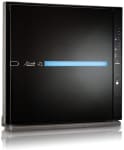
Purification method(s): BioGS HEPA filter, carbon filter, medium filter, pre-filter, customized filter, negative ion technology
Recommended main filter replacement: Every 12 months (for all of the filters that aren’t the pre-filter)
Filter replacement cost: $85 for a 4-pack containing a BioGS HEPA filter, a medium filter, a carbon filter, and one of the four possible custom filters
The Rabbit MinusA2 air purifier has a lot of useful and fun customization options. In addition to its five fan speeds (which include “Silent”), it also has an “Auto” mode and a “Pollen” mode, where the latter mode turns on once it senses pollen, and turns off automatically once the air has been cleansed.
In addition to all the usual filters, the Rabbit also allows you to insert one of four possible custom filters: Toxin Absorber, Germ Defense, Pet Allergy, and Odor Removal. If you’re looking to spice things up aesthetically, you can buy a version of this air purifier with a special panel (such as a panel depicting Hello Kitty) already in place. Lastly, if you’re worried about the Rabbit getting knocked over accidentally, you can mount this air purifier on a wall.
The Rabbit Air app (iOS/Android) is pretty robust; you can control every aspect of the air purifier’s operation, as well as set a timer or a schedule that will turn the air purifier on or off at certain times.
Note: the smart aspect of this air purifier only works on 2.4 GHz wi-fi networks, so if you only have a 5 GHz network in your home, you might not be able to take advantage of the Rabbit’s smart features.
During at-home testing, the Rabbit did a pretty good job of removing cooking smells and pot smoke from the air. Our tester found that the air quality indicator lights were pretty useful, and that even the fastest fan speed isn’t too loud. When it came time to test the Rabbit in the lab, we were pleasantly surprised to find that this air purifier almost completely removed all traces of the fish oil that had been planted inside our sealed testing room.
While the Rabbit has a nice deep handle, it’s a bit heavier than some of the other air purifiers we tested, so you might struggle a bit if you plan on moving it from room to room. Otherwise, the Rabbit Minu A2 air purifier is a perfect fit for someone who has very specific filtration or aesthetic preferences.
Pros
-
Very customizable
-
Can be mounted on a wall
Cons
-
Smart features only work with 2.4 GHz wi-fi networks
-
Expensive

Purification method(s): True HEPA filter, ionizer
Recommended main filter replacement: Every 12-15 months
Filter replacement cost: $129 for a True HEPA "fresh" filter, $139 for a True HEPA "heavy odor" filter, $139 for a True HEPA "pet odor" filter, $99 for a True HEPA "pure" filter
If you've ever wondered what it would look like if Apple designed an air purifier, look no further than the Alen BreatheSmart 75i. This air purifier's clean lines and sleek interface will definitely appeal to those who spend a lot of time on their smartphones. The control panel is streamlined and fairly intuitive, with the buttons for the fan speed, timer, filter status, and optional ionizer clearly labeled. While there are no specific air pollutant readouts, the circle around the air purifier's power button changes color to indicate the overall air quality in your home.
During smell testing, the Alen did a pretty good job of diffusing the smell of a cinnamon fragrance, so it'll be a good fit for those who have to contend with smells from spray bottles, such as cleaning solutions and perfumes. It also did a pretty good job of getting rid of the smell of fish oil, so it can conquer cooking smells as well.
While some of the fan settings can get pretty loud, a fact that is unsurprising when the air purifier is as big as it is, slower fan speed settings won't bother you when you bed down for the night. While the Alen comes with a pocket handle and wheels, it's still pretty tall and heavy, so if rolling it is not an option, we'd recommend keeping this air purifier in one room and let it work its magic there. If you want a big air purifier that cleans the air well and looks good doing it, be sure to check out the Alen BreatheSmart 75i.
Pros
-
Easy to use
Cons
-
Some loud fan settings

Purification method(s): carbon filter, True HEPA filter, ionizer
Recommended main filter replacement: Variable, depending on the environment, but typically every 6-12 months
Filter replacement cost: $20 for 2-pack of 2 True HEPA filters, $35 for 2-pack of 2 True HEPA filters with mold fighting power, $10 for 4-pack of 4 carbon filters
This modest little humidifier may not have the sleek looks or digital read-outs of other air purifiers on this list, but the Holmes HAP9726B is no joke. In our smell test, it was able to noticeably diminish the fish oil smell, but struggled more with cinnamon, as most air purifiers did with fragrances. During at-home testing, users noticed that dusty rooms seemed less so while the Holmes was running. One downside to this air purifier is that some of its fan speeds are pretty loud; that might deter users from actually activating the higher settings, which is a shame, since it seems to be able to move a lot of air quickly, and that might improve the air quality at a faster rate.
The Holmes air purifier has a very basic, intuitive control panel that includes fan speeds, a filter status light, and a button to toggle the optional ionizer, which can help to remove air pollutants that have small particle sizes. It comes with a handle that makes for easy moving, and the filter is easily accessed by popping open the front panel. If you can run the Holmes HAP9726B while you're away from home (or don't mind the noise, and can run it while you're there), when you return, your air quality will have improved significantly.
Pros
-
Powerful and efficient, for its size
-
Reasonably priced
-
Intuitive controls
Cons
-
Loud

Purification method(s): ultra-fine pre-filter, super ultra-fine particle filter, sorbent filter, additional water filters for humidifier
Recommended main filter replacement: Every 12 months
Filter replacement cost: N/A
The LG AM501YWM1 is the all-in-one air purifier and humidifier of your dreams. Like the LG AS560DWR0, this air purifier has all the bells and whistles. The control panel has, according to the manual, over 20 different symbols that live on the control panel, ranging from the amount of PM10, PM2.5, and PM1.0 particulates, filter and water bucket statuses, troubleshooting hints, odor and dust warnings, humidifier and air purifier settings, colored lights to indicate the overall air quality, and so much more.
The humidifier has a UV LED water treatment so as to kill bacteria in the water bucket, which makes sense because in addition to using either the air purifier or the humidifier singly, you can also select the Humid Purify mode, which uses the humidifier in conjunction with the air purifier to help cleanse your air. This air purifier is also compatible with LG's SmarThinQ app, so it can be controlled remotely from your smartphone.
We pitted the AM501YWM1 against the ever-pungent smell of cigarette smoke, and out of all of the air purifiers we tested, this one fared the best, in that testers could tell that there was a smell in the room, but had a tough time identifying it as cigarette smoke, which is a definite victory when it comes to cigarette smoke. It did equally well when it came to cinnamon, so if you don't want fragrance smells hanging around, this air purifier can help you out.
At-home testers found that some of the settings were a bit loud, but with this many options available, it's easy to select a quieter setting. Additionally, users found it difficult to decipher all of the icons on the display without really sitting down to read through the manual. If you're a tech-fiend, passionate about your air quality, and want your devices to look as good as they perform, we think you'll love the LG AM501YWM1.
Pros
-
Humidifier and air purifier in one unit
-
UV light helps to keep humidifier tank clean
Cons
-
Complicated panel
-
Very expensive
